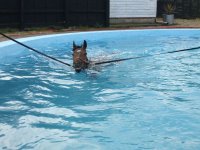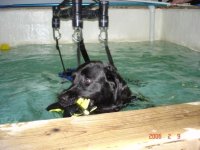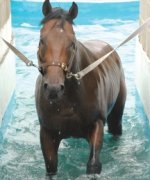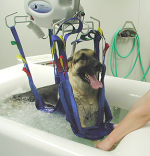Hydrotherapy for Horses
Equine massage therapists use hydrotherapy to accelerate the horse’s natural healing processes. Like all mammals, horses use Hunting’s Response to heal when injured; which is to say that the body’s blood vessels constrict after an injury, and followed by an extended dilation, and then more constricting. This is the body’s way of repairing tissue, and eliminating any congestion that accumulates near these injured tissues.
Hydrotherapy, formerly called hydropathy, is an ancient form of healing. According to legend, Asclepius, son of Apollo and the Greek god of medicine, first used hydrotherapy in 4500 BCE. Centuries later, Hippocrates, well-known as the Father of Medicine, used water at various temperatures to decrease pain and swelling and promote healing for many illnesses and injuries.
Today hydrotherapy is performed in much the same manner. It can be used before, during or after a massage treatment, but it also can also help horses heal more quickly when used on its own. Water can be applied in any of its three forms: water, vapor, and ice.
Ice therapy, also known as cryotherapy, is to used to treat acute conditions because it alleviates pain — by acting as a topical analgesic and by reducing inflammation. Applying ice also activates the Hunting’s Response. When an injury is deep and acute, inflammation is common, so ice can be applied repeatedly, as needed. But it must be used judiciously and by a skilled practitioner, as constantly applying ice can freeze superficial tissues.
Water or effusion therapy is wonderfully adaptable, and can be used at many stages of injury — to sedate, to stimulate, or sometimes to do both. Any injury still in the acute stage should be addressed using cold, while hot and cold treatments are used during the sub-acute stage. Heat is generally applied to chronic problems.
Heat acts as a temporary analgesic to decrease pain, but it also relaxes muscle fibers, and increases circulation and flexibility, and enhances waste removal. Directly applying heat causes vessels in superficial tissues to dilate, while vessels in deep-seated muscles constrict, pushing blood to the surface. That increases lymphatic drainage, allowing deep congestion to be removed from the area, which is so important in rehabilitating chronic injuries.
Contrast bathing, another hydrotherapy technique, is often used for sub-acute conditions. Using a 3:1 ratio, heat and cold is applied to the injury, with the application length dependent upon the stage of the injury.
Hydrotherapy is a wonderful tool for any therapist who works with horses, but knowledge and education are required for it to be effective. Knowledge and education will result in the most effective application, and that accelerates healing.




